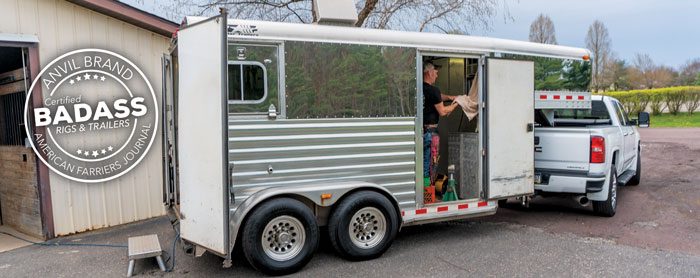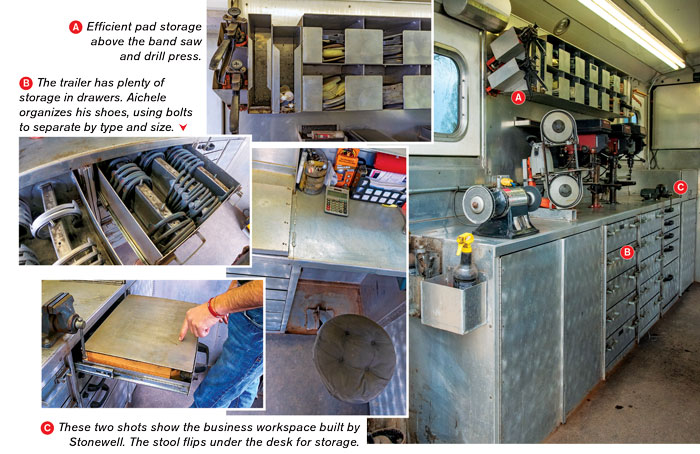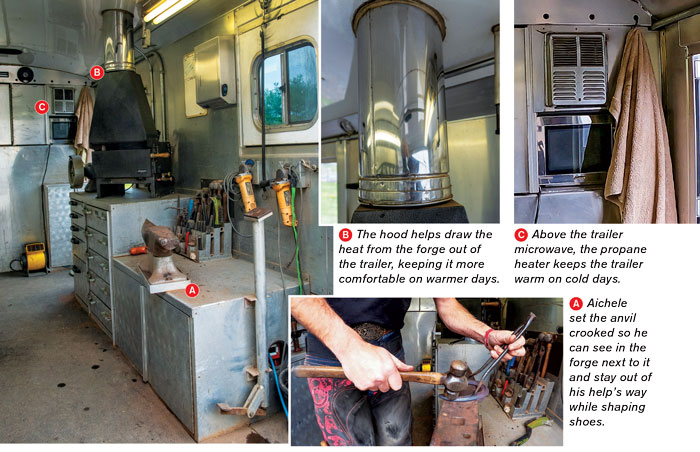When he looked at buying a new farrier trailer in 2004, Will Aichele recalls that the substantial cost was daunting. The Hilltown, Pa., farrier was about a dozen years into his shoeing career at the time and felt he was on firmer ground, compared with those early years in which many farriers struggle with establishing a business. He says for a farrier starting a career, a new manufactured rig is a frivolous spend with crippling debt that an immature business shouldn’t absorb. But as a practice matures, the body or trailer will still be a significant spend, but can be a wise investment.
“Absolutely, when I first bought it, I was worried about the cost,” says Aichele. “Looking back 18 years, I’ve shod a lot of horses and paid a lot of bills by using this trailer.”
Aichele worked with Stonewell Bodies to outfit this 4 Star trailer. As soon as he pulled the trailer out of the New York manufacturer’s shop, he began racking up the miles. Earlier in his career, he primarily shod reiners and Western pleasure horses, and had extensive travel to cover those clients.
“When I was working mostly on Quarter Horses, I was on the road 3-4 days a week before returning home,” he says. “I spent a lot of time in this trailer across the country. That was a reason we built the office space in the front of the trailer — a place to manage my business while on the road.”
Aichele doesn’t do as much driving now, able to keep his practice localized to Northeast Pennsylvania. Today, his business focuses on dressage, eventers, hunters and jumpers, and he is able to limit trave — although he covers clients who travel to Ocala, Fla., during the winter show season.
Investing in Your Business — At the Right Time
Aichele says he thought about comfort while working when considering the purchase. He wanted a trailer that he could minimize downtime in case there was an issue with his truck, but also to work inside it to avoid damp and cold conditions.
“Some farriers in my area worked out of trailers,” he recalls. “I used to look at the negative that trailers were too difficult to get in and out of barns. But then I thought that the more comfortable I am, the better my focus and work are. I examined it and only had one stop where I couldn’t get the truck and trailer into. That barn had two donkey trims, so that was a good reason to drop that account.”
Although the trailer keeps things dry, Aichele relies on a mounted RV propane heater to warm the trailer inside. It runs on a 12-volt system charged by the truck. The added benefit is regulating the temperature for adhesives.
Another advantage of the wide trailer setup is for workflow. Aichele says it helps so he can be at the anvil working, and another farrier can access the power tools or storage, and vice versa.
After nearly 20 years of pulling the trailer, Aichele says the only substantial repair was installing new axles. Even with that — and no plans on replacing the trailer — the farrier says he’s had a great return on investment.
“Of course, the trailer doesn’t have an odometer, but since 2004, I’ve logged the miles on the trucks that I’ve swapped about every 3 years. I work with another farrier, Steve Hunsberger, who also uses it. Maybe it is just under a million or just over, but it is the neighborhood.
“We can enter this trade with a minimal investment. For example, my first shoeing rig was a Jeep Comanche pick-up with a junkyard cap that I modified. Looking back at where I was when I bought this trailer, I made a decision to invest everything I had in my business because that was all I had. The trailer is quality and now there are no payments. When farriers invest in our businesses earlier, the wise investment will pay dividends long-term. I did struggle early to pay for it, but never regretted making this decision. Now that it is paid off, I look back and see that was smart business decision.”











Post a comment
Report Abusive Comment